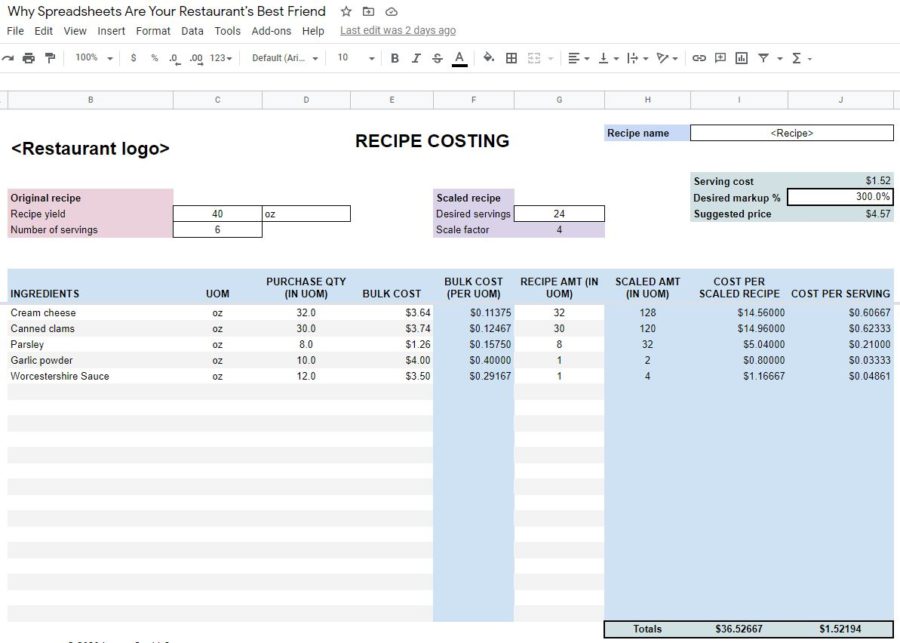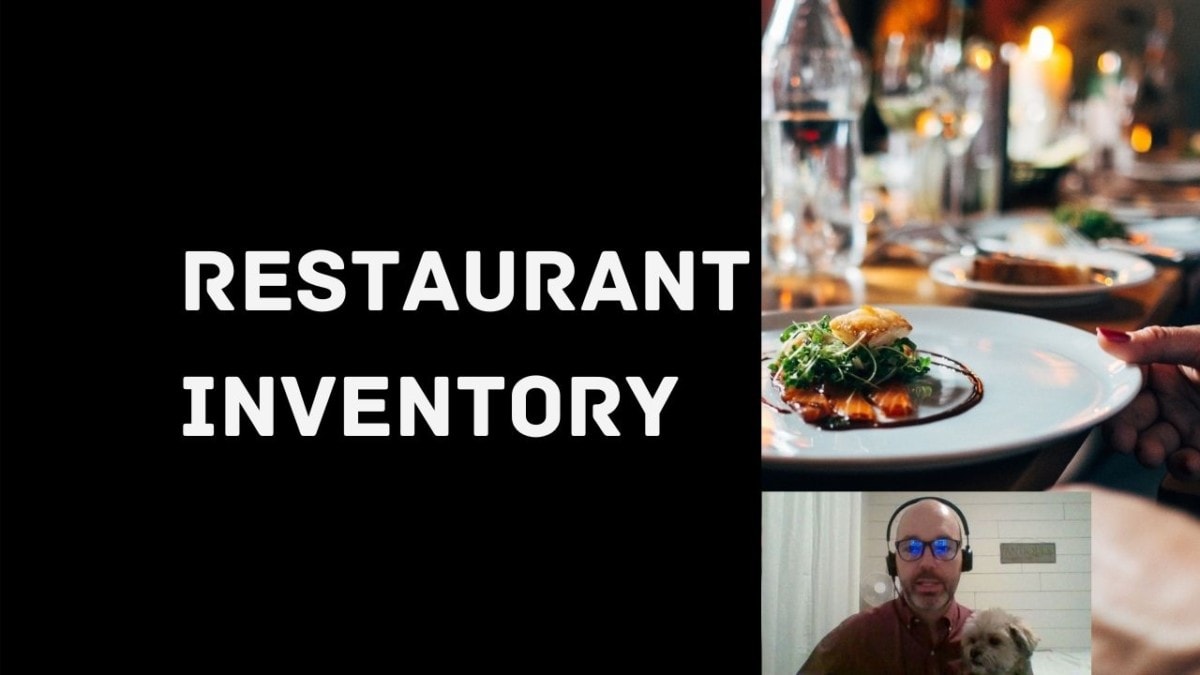
How do restaurants keep track of inventory? Video summary
Inventory is a pain. Especially in a restaurant where ingredients are constantly being consumed.
Don’t fight against the nature of your business. Schedule inventory counts when it will be easiest for you and your employees. For instance, during downtime and when inventory is at a minimum.
Whatever you do, don’t skip this important task! Keeping an accurate inventory is key for meeting customer demand and maximizing your restaurant’s profit!
Make sure that inventory counts are promptly updated in your inventory software or spreadsheets. Accounting software is useless if it doesn’t match reality. So, make sure your software is up-to-date. SpreadsheetsForBusiness.com, by the way, has a useful inventory control spreadsheet that you can download along with six other handy worksheets.
Speaking of software, utilize technology as much as you can. You’re busy. Take advantage of any reasonably priced help you can get.
Keeping track of stock and planning purchases
Restaurant managers and owners have to juggle a lot of different responsibilities. They also have to be knowledgeable in a number of different areas.
Scheduling, ordering, prepping, costing, pricing, setting a menu, and, of course, inventory control are just a few of those responsibilities. By the way, if you’d like help with those responsibilities, check out my Why Spreadsheets Are Your Restaurant’s Best Friend video/post/templates.
If any of those responsibilities are cumbersome or are disproportionately time-consuming, it might be tempting to stop doing them. Or at to least stop doing them correctly.
While they’re all important tasks, inventory control might seem like one of them that you can skimp on. Maybe it’s too much of a pain in the butt? Or, maybe it seems so simple that you handle it halfheartedly.
If that’s the case, hopefully, this video and post will help you identify some best practices to tighten up your inventory control to help your restaurant’s bottom line.
Implement smart restaurant inventory policies
Organization will make your restaurant inventory control much, much easier. So, if you are a naturally organized person, then you have an advantage here. If not, I would advise you to do your best to implement some of these organizational principles. You’ll be glad you did.
One way you can organize is by breaking your restaurant up into different inventory areas. For instance:
- Coolers
- Dry storage
- Preparation area
- Bar
- And so on…
These different areas can serve as categories if you decide to utilize the Why Spreadsheets Are Your Restaurant’s Best Friend inventory control tool.
Also, you hired employees so that you could accomplish more than you could by yourself. Don’t hesitate to use these assets when it comes to inventory control. Three trusted people handling inventory control will likely make the job more than three times easier.
Whatever accounting costing method you decide to use for your restaurant inventory is up to you. But, when it comes to actually pulling and consuming inventory, I would strongly recommend that you use the First In, First Out of (FIFO) method. This helps ensure that spoilage is minimized.
Consolidate inventory as you go. This will save space, leave room for new deliveries, and reduce the clutter at your restaurant. Doing so, along with disposing of expired inventory, should make this teeth-grinding task quicker and easier.
Count and record restaurant inventory
“How hard can it be to count?” you might be thinking. “I run a successful restaurant, I’m no idiot.” And, right you are.
You know how to count. But, have you ever considered when to count? There are two answers to that question.
The first thing to decide is how often to count. Daily? Weekly? Monthly? I wouldn’t suggest that you do it any less frequently than monthly. Things are liable to get out of hand if you wait that long. How often to count depends, in large part, on the amount of inventory you carry. If you carry a lot, then you should probably count more often.
One thing to consider is when you receive most of your deliveries. Ideally, you’ll be counting shortly before that, so that you can minimize the amount of counting you have to do.
The other thing to consider when deciding when to count inventory is what part of the day should you do it. That answer is easier. Counting inventory before or after operating hours will save you a lot of hassle.
Finally, make sure that you count using consistent units of measure (UOM). You don’t want to count something in gallons one week and ounces the next. Also, no matter how often you count, no matter what UOM you use, make sure to update your quantities on hand in your software. Even if that software is just a spreadsheet.
Look up restaurant inventory costs
Now that you know your inventory quantities, it’s time to address the other side of the inventory value equation – the unit cost.
Food costs are very volatile. Plus, ingredient usage can be hard to track. Therefore, it’s probably best to use your last purchase order cost. This should be pretty accurate if you’re counting your inventory on a fairly frequent basis.
Using your last purchase order cost will help ensure that your inventory value and cost of goods sold (COGS) is accurate.
Looking up costs after every inventory count will also help you stay on top of changes. You’ll have a better intuition about what’s eating into your profit or helping your bottom line from an ingredient standpoint.
I know you didn’t get into the restaurant business to count and to look up costs. Again, utilize help from your staff where you can. COGS is a huge driver of restaurant profitability, so it pays to manage this stuff carefully.
Cost and usage of every ingredient
Staying on top of your food costs will help you make sure that you’re pricing appropriately and staying profitable. Speaking of costing and pricing, again I would suggest you check out my Why Spreadsheets Are Your Restaurant’s Best Friend templates. Specifically, the Food Costing worksheet. On it, you can scale recipes up and down and get a suggested price based on the cost and your desired markup percentage.

Understanding your costs and the profitability of every dish you serve will help you make smarter menu decisions. You’ll know what to promote more and what to drop off your menu.
You certainly don’t have to use my worksheet, but utilize technology to the fullest extent practical. You’re busy as it is, so take every advantage you can get to work more efficiently and effectively.
Finally, staying on top of inventory quantities, costs, and usage will help you be proactive in catching instances of theft and loss. If you’re not managing these things, then you can probably see how theft and loss would easily slip through the cracks.
Keep an eye on restaurant inventory
Excess inventory is a problem for every business. But, restaurants in particular. Over-ordering inventory takes up valuable space and it’s a waste of money. Even if the inventory gets used in a restaurant before it expires, it’s still like sitting money on a shelf. Money that you could be used to earn an ROI elsewhere.
Money that is tied up in excess inventory could be used to buy ingredients that you are consistently running out of and are losing sales on. Or, it could be used to hire more staff. Staff that could help you count inventory!
Taking consistent inventory counts and tracking usage will also help pinpoint and deter theft. Unfortunately, dealing with potential theft is just a part of running a restaurant. Everybody likes food and a lot of people like alcohol. Therefore the risk of theft runs higher for restaurants than it might for other businesses.
POS software and other technology can help
Tracking inventory is nobody’s idea of fun. But, by staying on top of it you can avoid inventory catastrophes which everyone agrees are downright painful.
So, get all the practical help you can by utilizing software or spreadsheets. Be sure to do your homework on any software you’re looking to pay for and get the training that you and your staff need to use it effectively. In many cases, especially if you’re a smaller restaurant, relatively simple spreadsheets might make more sense than specialized software. They take a little bit to set up, and they’re not foolproof. But, they are almost 100% customizable.
Restaurants, like all other businesses, strive to get as many benefits as they can for the costs they incur. Remember, though, that cost can also be measured in time. Keep that in mind when considering software tools to help you work more efficiently and effectively.
Questions about restaurant inventory
How can I manage all my inventory in my restaurant?
The fundamentals of managing inventory in a restaurant include consistent inventory counts, keeping track of costs, and understanding usage. Get buy-in from your employees to help with these tasks and utilize software tools to manage your restaurant inventory efficiently and effectively.
How much food inventory is lost due to spoilage at the average restaurant?
It’s estimated that 4% to 10% of food in restaurants is lost to spoilage, theft, or waste. With food cost making up approximately 30% of a restaurant’s total cost, excess waste can really hurt your bottom line. Therefore, it makes sense to learn about and implement policies regarding smart inventory management.
What are the best mobile and tablet apps for restaurant inventory?
One app you might try out is called Fishbowl. Fishbowl is a software tool built to connect to QuickBooks Online. This is nice because your inventory control will tie directly in with your accounting software.
Speaking of QuickBooks Online, I’ve written several posts (and made several videos) on the subject.
To be clear, I have not tried Fishbowl. I cannot speak, personally, to its effectiveness. However, it did appear to be well-reviewed. So, I think it would be worth checking out if you’re looking for a mobile or tablet app besides spreadsheets.


